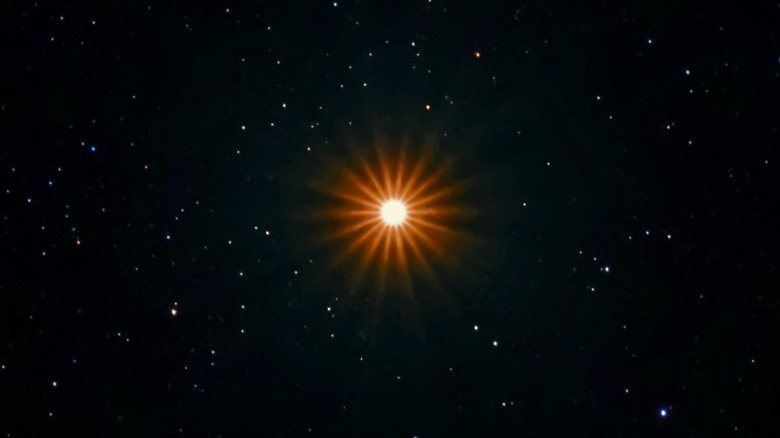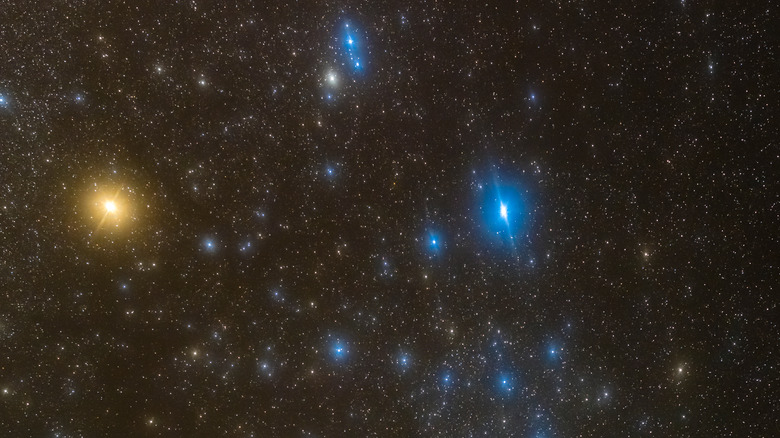The Real Reason The Betelgeuse Star Dimmed So Much In 2019
Since ancient times, humanity has gazed in wonderment at the stars. Even today, those few that can be seen by big-city-dwellers against a backdrop of light pollution have the same effect. There's just something majestic, unknowable and fascinating about them.
Over the centuries, our ability to document, study, observe and comprehend stars has advanced in a whole array of ways. Though there's still so very much to learn, there's certainly no shortage of case studies. According to NASA's Blueshift, there are estimated to be anywhere between 100 to 400 billion stars in our galaxy alone, and potentially even more still. One of the most notable stars is Betelgeuse, an enormous (and enormously bright) celestial body. In 2019, it seems, Betelgeuse was discovered to have been Twinkle Twinkle-ing far less brightly. The science behind this phenomenon is complex, but it seems that the star is becoming very unpredictable as a result of its old age.
According to Britannica, Betelgeuse (Alpha Orionis) is 548 light-years away from us, one of the most famous elements of the Orion constellation. It's a supergiant that has, naturally, drawn the eye of the Hubble Space Telescope many times over the years. In 2019, humanity's iconic eye in space noticed that Betelgeuse was going through some curious changes.
Betelgeuse burning bright
Per NASA, Betelgeuse started getting mysteriously dimmer in October of 2019. The following February, it was only one-third of its former brightness, and did not get back to its usual brilliantly bright state for another month and a half.
Scientists were fascinated to study exactly what had happened to Betelgeuse. According to Center for Astrophysics associate director Andrea Dupree, the Hubble Space Telescope showed that a vast and thick layer of dust formed over some of its area, having a dramatic effect on the star's brightness. September of 2019 saw Hubble detect such material starting to move in the star's atmosphere, per NASA, and this continued as the darkening set in. "This material was two to four times more luminous than the star's normal brightness," Dupree stated. "About a month later, the south part of Betelgeuse dimmed conspicuously as the star grew fainter. We think it is possible that a dark cloud resulted from the outflow that Hubble detected."
In August of 2022, Live Science offered some further insight into exactly why this happened. Apparently, Betelgeuse is becoming particularly cranky in its old age. Per Britannica, supergiant stars, while they can survive for millions of years, have short lives in terms of the remarkable life cycles of other types of star.
What does Betelgeuse's behavior really mean?
A February 2021 study by the Kavli Institute for the Physics and Mathematics of the Universe in Japan determined that Betelgeuse is "in the early core helium-burning phase." This is to say, it's likely to explode in a dramatic supernova imminently (in around 100,000 years). This supernova, with the star being so far away, would reportedly not endanger us, but it would certainly be visible (and very informative for scientists).
The study also corroborates the possibility that a heavy dust cloud was the cause of the star's dramatic dimming. What caused that, though? A sort of preliminary explosion, it seems. In August 2022, Dupree et al released the study "The Great Dimming of Betelgeuse: a Surface Mass Ejection (SME) and its Consequences" (via Arxiv). According to the researchers, "A photospheric shock occurred in 2019 January-March, progressed through the extended atmosphere of the star during the following 11 months and led to dust production in the atmosphere."
NASA's Hubblesite explains that Betelgeuse blew off a huge part of its own surface in a surface mass ejection, an event 400 billion times stronger than the sun's equivalent coronal mass ejections. The aged supergiant's fate and the timeline for it remain uncertain as it recovers from the ejection, but these events are as unprecedented as they are fascinating. "We've never before seen a huge mass ejection of the surface of a star," Dupree reported.


